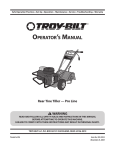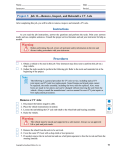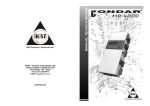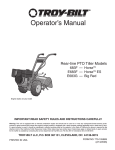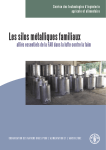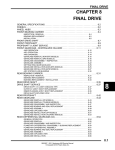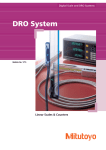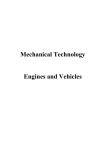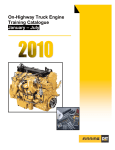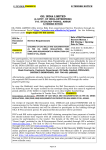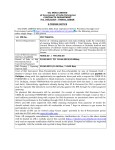Download Diesel Fuels - Goodheart
Transcript
This sample chapter is for review purposes only. Copyright © The Goodheart-Willcox Co., Inc. All rights reserved. Chapter 14 304 Diesel Technology Diesel Fuels After studying this chapter, you will be able to: K Explain diesel fuel grades. K Discuss fuel properties and characteristics. K Explain the reason for the use of fuel additives. K Describe the proper procedures for handling and storage of diesel fuel. K Name the various alternative fuels and their properties. lubricating oil, and paraffin are obtained. Finally, only coke and asphalt remain. The type of hydrocarbons obtained will vary depending on the original geographic location of the crude oil. This heating of crude oil to obtain various hydrocarbons is known as distillation. It is a highly complicated process and precision control of pressure and temperature is required. Figure 14-1. A fractionating column is used to separate crude oil into the various hydrocarbon products. As the vaporized products rise in the tower, they settle onto trays at different levels and are then piped out to other equipment for further refining. (Allis-Chalmers Engine Div.) Diesel Fuel Grades All engines have a few things in common. One of them is that they all need fuel in order to operate. Most mobile and stationary engines use fuels derived from crude oil. Diesel engines use several variations of diesel fuel, depending on their application. In this chapter, you will learn about the different types of diesel fuel used in diesel engines. Hydrocarbon Fuels The liquid fuel used to operate diesel engines is obtained from crude oil. Crude oil consists of a mixture of hydrocarbons (hydrogen and carbon) and compounds such as benzene, petane, hexane, heptane, toluene, propane, and butane. These compounds have different relative volatility points because they will vaporize, or flash, at different temperatures. Hydrocarbon fuels are separated in a fractionating column. As crude oil is heated, these hydrocarbons are given off as a vapor, Figure 14-1. After the natural gas is vaporized from the crude oil, the applied temperature is raised and the hydrocarbon with the next highest vapor point is obtained. The first hydrocarbon engine fuel obtained is high octane aviation gasoline. If everything is working properly and you continue to raise the temperature, other hydrocarbon fuels such as commercial gasoline, kerosene, diesel fuel, domestic heating fuel, industrial fuel oil, While the American Society of Testing Materials (ASTM) has divided diesel fuels into three classifications, only two recommended grades are considered acceptable for use in high-speed trucks and buses in North America. These are the number 1D and number 2D classifications. Grade number 4D, the heaviest diesel fuel, is used in large stationary constant-speed engines or in some marine applications. Number 4 and bunker fuels are not used in high-speed mobile diesel engines, which are continually accelerating and changing speed. Grade number 3D was discontinued a number of years ago and is obsolete. The Canadian government 3-GP-6D diesel fuel has its own fuel specifications recognizing five categories of diesel fuels, with even more restrictive standards set by ASTM. Each individual refiner and supplier attempts to produce diesel fuels that meet as closely as possible with ASTM and American Petroleum Institute (API) standards, Figure 14-2. Depending on the crude oil source, the diesel fuel end product may be on either the high or low end of the prescribed heat energy scale in Btus per gallon. This is why individual diesel fuels grades may vary slightly from one supplier to another. Grade 1D is generally the most refined and volatile diesel fuel available. It is a premium fuel used in high rpm engines requiring frequent changes in load and speed. Grade 2D is more widely used in truck fleets due to its greater heat value per gallon, particularly in warm to moderate climates. Although Grade 1D fuel has better properties for cold303 Figure 14-2. General classification chart for diesel fuel. (Detroit Diesel) weather operation, many fleets still use Grade 2D in the winter. Other cold weather aids include a fuel heater/water separator for easier starting, as well as fuel additive conditioners that can be added directly to the fuel tank. Like gasoline, diesel fuels are blended on a seasonal and geographical basis to satisfy anticipated temperature conditions. It is usually best and cheapest to burn the heaviest fuel that will work under given circumstances. Heavier grades of diesel can usually produce more energy than light grades, just so long as the increased viscosity does not make the fuel too thick to flow and inject properly. It is important to remember that the wrong grade of diesel fuel can affect the operation of the engine. If an engine is not developing the proper horsepower, an improper grade of diesel fuel could be the cause. An easy way to confirm this is to use a diesel fuel quality tester such as shown in Figure 14-3. Diesel Fuel Properties In a diesel engine fuel system, the fuel itself performs three functions. It supplies chemical energy to be transformed into mechanical energy, lubricates precision parts in the fuel system components, and cools metal surfaces operating in conditions of friction. The properties or characteristics of diesel fuel must meet these three if the engine is to perform with reliability. This sample chapter is for review purposes only. Copyright © The Goodheart-Willcox Co., Inc. All rights reserved. Chapter 14 Diesel Fuels 305 306 Diesel Technology Flash Point Figure 14-3. A typical diesel fuel quality tester. (Kent-Moore Tools) Fuel processors, as well as engine manufacturers, run laboratory tests on all fuel used in diesel engines. These measured properties give a good indication of the way the fuel will perform, however, there is no real substitute for an actual engine test. The major diesel fuel properties affecting engine performance are: K Heat value. K Specific gravity. K Flash point. K Volatility. K Cetane number rating. K Pour point. K Cloud point. K Viscosity. K Carbon residue. K Sulfur content. K Fungus and bacterial contaminants. K Oxidation and water. Heat Value The heat value of fuel is a general indication of how heat energy is supplied to an engine and how well the engine converts heat energy into work. The heat value can be found by testing with a calorimeter. With this test, a premeasured amount of fuel is burned and the amount of heat emitted is carefully measured in Btus per pound of fuel. A British thermal unit (Btu) is the amount of heat required to raise the temperature of one pound of water one degree Fahrenheit. The metric equivalent of this unit is known as a joule. To convert Btus into joules, multiply by 1054.8. Specific Gravity The specific gravity of fuel is a ratio of the fuel density to the density of water. It is measured using a hydrometer. Specific gravity affects the fuel’s spray penetration as it is injected into the combustion chamber. Because water is the standard, it has a specific gravity of one. Since oil floats on water, a diesel fuel’s specific gravity is always less than one. Diesel fuel’s specific gravity ranges from 0.8 to 0.94. Specific gravity is also a factor in measuring the heat value of the fuel. In general, heavier fuels usually have a greater heat value per gallon (Btus) than lighter fuels. Thus, specific gravity is a good indicator of the amount of heat (Btus) available in a given amount of fuel. The American Petroleum Institute (API) employs another scale to determine specific gravity. Water has a specific gravity of 20 on the API gravity scale. Ten is the lowest value on this scale, the reverse of the system just described. Diesel fuels generally range from 20 to 45 on the API gravity scale, with most ranging between 34 to 36 at 60°F (15.5°C). A fuel’s flash point is the lowest temperature at which it will give off flammable vapors in sufficient quantity to flash or momentarily ignite when brought into contact with an open flame. The flash point has no effect on engine performance or on its ignition qualities. It is specified simply as an index of fire hazard⎯a fuel oil with an extremely low flash point is dangerous to store and handle. Diesel fuel flash points are not an indication of how they will ignite in an engine cylinder, however. This depends on the ignition quality of the fuel. For example gasoline, which has a very low flash point, would be a very poor diesel fuel due to its ignition quality. Volatility Volatility is a fuel’s ability to change to a vapor. It is indicated by the air-vapor ratio that is formed at a specific temperature. Diesel fuel volatility is indicated by a 90% distillation temperature (the temperature at which 90% of the fuel is distilled off). As volatility decreases, carbon deposits and engine wear increase. Depending on such factors as the combustion chamber condition, more smoke will also affect power output, performance, starting, and warm-up. Cetane Number Rating The ease of diesel fuel oil ignition and the manner in which it burns determine the ignition quality of the fuel oil. Diesel fuel oil is injected into the combustion chamber in liquid form. The fuel must then be able to vaporize quickly and ignite without a flame or spark. This ability to vaporize and ignite easily is called ignition quality. The ignition quality of a diesel fuel is determined by its cetane number rating, or cetane value. The cetane rating or value of a diesel fuel is based on the ability of the fuel to ignite. The cetane rating of a fuel is determined by comparing it with pure cetane, which is a test fuel, and is identified by a cetane number, Figure 14-4. This cetane number represents the percentage of pure cetane in a reference fuel which will exactly match the ignition quality of the fuel being tested. The cetane rating scale ranges from 0 to 100, with 100 being the highest ignition quality. In general, the higher a fuel’s cetane rating, the lower the emissions. Currently, a 40 cetane or above rating is standard for all on-highway diesel engines. (In some areas, 50 cetane and higher are current standards.) Newer diesel engines may require higher cetane fuel. The diesel engine service manual will specify what cetane number to use. Improving Ignition Quality Fuels with poor ignition qualities can be improved or reformulated by blending them with fuels that have good ignition properties. The cetane number of such blends are an average of the cetane numbers of the individual fuels. To meet the cetane number required by most on-highway vehicles, cetane improvers are added to the blends. The lower cetane compounds are less responsive to these improvers than the higher cetane paraffin fuels. Figure 14-4. Comparison of the relationship between octane and cetane. Note that as the cetane number increases, the burn rate increases. ambient temperature, engine performance will be satisfactory. The most commonly available and recommended fuel oil, grade 2D, has a cloud point or WAP of 10°F (-12°C), while the thinner grade 1D has a cloud point of -20°F (-28.8°C). In extremely cold areas, engine clogging can be minimized by using only grade 1D in winter. In most places, mixing a base of grade 2D with grade 1D, or other special additives will work well in colder weather. As a rule, grade 2D’s cloud point drops two degrees for every 10% of grade 1D that is added up to a ratio of 50:50. One of the most effective chemical means for lowering the fuel’s cloud point is by blending #2 diesel fuel with kerosene. Fuel suppliers will often do this themselves and market it as “winter fuel.” Although this fuel will be more viscous at lower temperatures, its performance will still vary depending on where it was purchased. A 40/60 blend in one area may have a higher cloud point that a 40/60 blend in another. A fuel additive with a cloud point depressant will have limited effect. At most, it will lower the cloud point by 3-4°. Pour Point The improvers promote early, uniform ignition of fuel and prevent high pressure increases in the combustion cycle. Depending on the amount of cetane components in the base fuel, typical alkyl nitrate additive treatment can increase cetane by three to five numbers (1:1000 ratio). With high natural cetane premium base fuels (containing a high percentage of paraffins) and a 1:500 alkyl nitrate treatment ration, cetane may increase as much as seven numbers. Most improvers contain alkyl nitrates, which break down readily to provide extra oxygen for combustion. They also break down and oxidize fuel in storage. However, they also generate organic particulates, water, and sludge, all of which degrade fuel quality. Recently, several new cetane improvers or reformulaters without alkyl nitrates have been used and, properly blended, will improve oxidation stability while providing a cetane increase of two to five increments. It is only recently that engineers have learned how important the cetane level is in meeting the emissions equation. The air-fuel mixing time in a direct-injected diesel is about one-tenth the time of a carbureted gasoline engine. Early ignition promotes smooth and complete combustion, leading to reduced emissions. Excessive delay can produce very high peak cylinder pressures which make for rough and noisy engine operations. The higher the cetane number, the shorter the ignition delay, which is the time between the start of fuel injection into the cylinder and the actual start of combustion. Cloud Point Diesel fuel contains paraffin, and in cold temperatures wax crystals can start to form, accumulate, and clog engine filters. The temperature at which this happens is referred to as the cloud point or wax appearance point (WAP). Generally, if the fuel’s cloud point is at least 10° below the Pour point is another common way of measuring a diesel fuel’s performance in cold weather. It is the minimum temperature at which fuel can flow and is expressed as the temperature 5°F (8.8°C) above the level at which the oil becomes solid or refuses to flow. The pour point averages about 10° lower than the cloud point. Fuel treated with special additives called flow improvers or wax modifiers keep the wax crystals from forming clumps and choking fuel lines. They will generally give satisfactory performance at 9° lower than untreated fuel. However, fuel improvers do not have any impact on the fuel’s cloud point, since they do not prevent the formation of wax or paraffin crystals themselves. Viscosity Viscosity or stiffness is the property of a diesel fuel that resists the force which causes the fluid to flow. It is related closely to specific gravity and pour point. Two common methods of measuring viscosity are the Saybolt test and the kinematic centistokes test. Both tests involve heating the oil to an exact temperature and measuring its flow rate through a standard sized orifice. The viscosity of diesel fuel is generally specified at 100°F (38°C). Viscosity of fuels for medium-speed and highspeed engines normally ranges from 2.4 to 4.1 centistokes (cSt), or about 39 seconds Saybolt Universal (SSU). In general, any fuel with a viscosity lower that 2.4 cSt or 34 SSU, when measured at 100°F (38°C), will be too thin and could damage injectors as well as other parts of the fuel system. Diesel fuel also has a low viscosity index, meaning that it is thin when hot but gets thick when cold. A diesel fuel that can go through an injection system easily in warm weather may get too thick to flow properly in cold weather. As mentioned previously, diesel fuel is supplied in several grades. Grade 1D is a winterized diesel fuel. It is thinner or less This sample chapter is for review purposes only. Copyright © The Goodheart-Willcox Co., Inc. All rights reserved. Chapter 14 Diesel Fuels viscous than grade 2D, which is the fuel used at normal operating temperatures. Diesel fuel viscosity also affects the spray pattern in the combustion chamber, Figure 14-5. Low viscosity creates a fine mist, while high viscosity results in coarse or heavy atomization. In other words, viscosity affects: K Lubrication capability at various temperatures. K Atomization, or spray capability. K Ignition and burning characteristics. Therefore, viscosity is a very important consideration when selecting a diesel fuel. Carbon Residue Ash or carbon residue is the deposit left in the combustion chamber due to incomplete combustion or the use of fuels made from residual blends. It can be measured in the laboratory by heating a measured fuel sample in a closed container in the absence of air. Carbon residue is the final product that remains in the container after heating. This product is then expressed as a percentage by weight of the original sample. The amount of carbon residue considered acceptable in diesel fuel oil varies depending on the combustion chamber design, the injector adjustments, and the general condition of the engine. This amount is generally more critical in small high speed engines than in large slow speed industrial engines. Soot ash, which originates from either additives or the crude oil itself, also causes wear of fuel injection components, the pistons, and the piston rings. Standard requirements allow for a maximum of .001% soot ash content. Due to air quality concerns, future legislation may further limit the amount of soot ash a diesel engine can produce. Sulfur Content The wear of pistons, rings, and cylinders in a diesel engine generally increases when there is an excessive amount of sulfur in the fuel. Excess sulfur content also 307 causes varnish to form on the piston skirt and creates oil sludge in the engine crankcase. Sulfur also combines with water to form corrosives as a result of the combustion process. These corrosives can etch finished surfaces, accelerate engine wear, attack softer metals (such as bearings), and deteriorate engine oil. Similar corrosion damage from sulfur is frequently found in the engine’s exhaust system. Sulfur and aromatic content of diesel fuel are most responsible for harmful exhaust emissions. Sulfur dioxide emissions are reduced when sulfur content is reduced. The reduction of aromatics will reduce carbonaceous particle emissions. Sulfur is removed from diesel fuel in a process called hydrotreating. Hydrogen is used with a catalyst at temperatures between 500 and 800°F (260 and 430°C) to react with the sulfur compounds present. The reaction forms hydrogen sulfide, which is separated from the hydrocarbon and sent to a sulfur plant to be converted to elemental sulfur. The sulfur content can only be determined by chemical analysis of the fuel. EPA regulations mandate the sulfur content in diesel fuel. The 2004 standards called for a sulfur content of no greater than 500 parts per million (.05% by weight) and a maximum aromatic content of 35% in all on-highway diesel fuels. EPA regulations for 2007 on-highway engines require the use of ultra-low sulfur diesel fuel (ULSD). ULSD has a dramatically lower sulfur content than previous onhighway grade diesel fuels. The sulfur content of ULSD cannot exceed 15 parts per million (.0015% by weight). Using ultra-low sulfur diesel dramatically reduces diesel exhaust emissions. The lower sulfur content of ULSD produces fewer sulfate emissions. It also enables use of emissions reduction equipment, such as particulate traps and catalytic converters, that lowers emissions of particles and nitrogen oxides (NOx). When these systems are used with ULSD, emissions of fine particulates can be reduced by more than 90% and emissions of hydrocarbons can be reduced to nearly undetectable levels. Even without special emission reduction equipment, using ULSD reduces sulfate pollutants. ULSD fuel provides significant clean air benefits while ensuring the same energy and performance standards as regular highway diesel. Ultralow sulfur, low aromatic, and high cetane number diesel fuels enhance engine performance because improved engine combustion results in easier starting, smoother running, less noise, and less smoking during start-up. Only off-highway, non-road diesel engines can currently use higher sulfur content fuels. These include farm tractors, boats, locomotives, and stationary engines. The 2007 sulfur content standard for non-road, locomotive, and marine fuel (NRLM) is 500 parts per million (ppm). In 2010, all on- and off-highway non-road (NR) diesel fuel will need to meet a limit of 15 ppm sulfur, and in 2012, locomotive and marine (LM) diesel fuel will also be regulated at 15 ppm. Fungus and Bacterial Contaminants Figure 14-5. Proper fuel viscosity results in a good spray pattern. However, improper viscosity will give a poor spray pattern. Fungus and bacteria are the most common contaminants found in diesel fuels. Fungus and bacteria live in the 308 Diesel Technology water and feed on the hydrocarbons found in diesel fuel. These contaminants are called hydrocarbon utilizing microorganisms (HUM). HUM will spread through a fuel system where moisture or trace amounts of water are present. The resulting bacterial problems can shorten engine filter life. Draining the fuel system will reduce HUM activity, but will not eliminate it. The only way to eliminate HUM growth entirely is to treat the fuel system with a biocide. parts; and others that are oxidation inhibitors. In addition, remember that geographical locations, operating conditions, type of fuel storage, handling methods, and maintenance procedures are all factors that can determine whether or not a fuel additive might help a diesel fuel. In most cases, the fuel supplier or marketer will select and add the additive they believe will best improve the quality of their fuels. Fuels containing special additives may be more expensive than those without additives. Oxidation and Water Precipitants and particulates are noncombustible materials formed when either two incompatible fuels are mixed or when a fuel oxidizes. Oxidation can occur when an unstable fuel circulates through a diesel engine. Precipitants and particulates will normally settle out in low or slow flow areas of the fuel system or become part of the tank’s bottom sludge. Both can get mixed into the fuel system during fuel delivery and can plug fuel filters. Water causes the greatest concern because it is the most common form of diesel fuel contaminant. Water is found in the fuel system in two forms, free and dissolved. Most diesel fuels contain some dissolved moisture. Diesel fuel has a saturation level of water at any given temperature. As the temperature goes down, the fuel will hold less dissolved moisture. There is currently no common method of removing dissolved water from diesel fuel. Free or nondissolved water in the fuel tank usually comes from bulk storage tanks, from condensation, or from dissolved water. Free water mixes with the fuel as storage tank bottoms become agitated while dispersing or receiving fuel. When water in vapor form is present in air, it is called humidity. As air replaces fuel in storage tanks or vehicle tanks when the tanks disperse or receive fuel, moisture in the form of humidity finds its way into the fuel system. From there, moisture may condense as hot fuel returning from the injectors flows back into the cooler fuel tank. Free water in liquid form is heavier than diesel fuel and settles on the low flow or slow flow areas of the fuel system. The reverse is true when water freezes. Ice is lighter than diesel fuel and floats in the system to create plugs in fuel separators, filters, even going as far as the fuel pump injectors. Fuel Additives Generally, no fuel additives are necessary when a good quality, clean, and properly selected fuel is used. Certain fuel characteristics, however, can be improved by treatment with a fuel additive or conditioner. As already mentioned, additives are used to improve fuel flow properties under cold or winter-like conditions, increase the cetane number of the fuel, and to introduce a biocide to the fuel to prevent fungi and bacteria from growing in the diesel fuel. There are a number of commercially available fuel additives that will reduce smoke and corrosion of vital Fuel Handling and Storage The importance of clean fuel in the operation of a diesel engine cannot be overemphasized. Diesel fuel is generally delivered clean and free of impurities. However, every time it is transferred or handled, the risk of contamination increases. While fuel storage and its handling are not normally within the engine technician’s job classification, the results of improper storage and handling certainly are. A problem often found by the engine technician when troubleshooting a diesel engine is dirty fuel. One of the major problems either in storage or in the engine’s fuel system is leakage. Each connection or fitting in either system is a potential source of leakage. There are two phases to the leakage problem: K The visible leakage of fuel from a line during operation and shutdown. K The opening in a suction line or fitting which pulls foreign material into the system during operation and may or may not present a visible leak during shut-down. Visible leakage should be stopped as soon as it is discovered. Loss of flow volume generally means a loss of pressure. The leak which allows fuel contamination by pulling in air, water, or dirt is more difficult to locate and can be more damaging. Foreign materials, such as air, sediment (dirt), and water present problems and can enter the fuel system in various ways. Air Air drawn into the fuel system may make pick-up of fuel much more difficult or prevent it entirely. In addition, it may show up as: K Low power. K Gear pump wear. K Rough operation. K Soft or non-responsive throttle. Air enters the fuel in any one or more of the following ways: K Suction leaks (lines, fittings, filters, or tank). K Fuel turbulence, especially when coupled with poor tank venting. K Fuel pick-up point near return. K Combustion gases entering injector. This sample chapter is for review purposes only. Copyright © The Goodheart-Willcox Co., Inc. All rights reserved. Chapter 14 Diesel Fuels Dirt Dirt is as damaging to moving parts in the fuel system as it is in any other part of the engine. Dirt can: K Clog filters. K Abrade metal surfaces. K Increase combustion chamber deposits. Dirt enters the fuel when: K A suction leak is in an exposed area. K Dirt collection in the tank allows it to be picked up with the fuel. K Careless filling and handling permits mud, dust, or grime to enter tank or lines. The technician may unintentionally add dirt to the fuel system by: K Using containers and tools exposed to dirt. K Using lines and fittings that have accumulated dirt or dust without cleaning them out. K Allowing dirt to enter a line while it is removed for repair. This is especially critical between filter and pump. Water Water in the fuel may show up as low power, also, but it is even more damaging as already stated when it simply contributes to corrosion on fuel system components. Water enters the fuel system through: K A suction leak in an exposed location. K As condensation due to warm fuel. K Careless storage and handling. Careless storage and handling of diesel fuels can be a major concern in the engine’s operation, Figure 14-6. It is important to periodically perform inspection, cleaning and maintenance checks on all fuel handling and filtering equipment. Many state and local regulations include record keeping and periodic inspections. 309 310 Diesel Technology Storage Tanks Diesel fuel tanks may be underground storage tanks (UST), or above-ground storage tanks (AGST) systems. Fuel stored in AGSTs will deteriorate more quickly than the fuel stored in USTs due to sunlight exposure and the greater temperatures found above ground. Tanks are made of steel, fiberglass, or steel clad with fiberglass. Galvanized copper tanks are not used to store diesel fuel. There is a chemical reaction between the fuel and copper that produces a residue which will quickly clog fuel filters. The term “tank systems” includes the piping connected to the tank(s). In some large industrial operations, diesel fuel is fed from the main supply tank located (above or in the ground) outside of the building to a one day tank in the engine room, Figure 14-7. This tank has a sufficient capacity to provide fuel for one day of operation. The main storage normally stores only a one week supply of fuel. Fuel stored for longer periods of time can form gum which, along with corrosive compounds, causes deterioration. Many refineries are also using additives that help stabilize the fuel in order to reduce gum formation. Moisture condensation inside a fuel storage tank increases as the tank size increases. Condensation in a large tank can be reduced by using a series of smaller tanks and connecting them into the line as needed. The size of tanks is generally controlled by the Bureau of Fire Underwriters and local regulations. Alternative Fuels The Clean Air Act of 1990 requires that all centrally fueled on-highway transportation operations of 10 or more vehicles in certain high-emission areas are to phase in alternative fuel vehicles beginning in 1998. The act does not mandate any specific alternative fuels such as gasoline Figure 14-7. Schematic of a stationary fuel system with day tank and storage tank. (Waukesha Engine Div.) or diesel. The alternative fuels now being considered for use with compressed (diesel) type engines are compressed natural gas (CNG), liquefied petroleum gas (LPG), liquefied natural gas (LNG), and alcohol based products such as methanol and ethanol. The Clean Air Act regulations are closely tied to clean fuel vehicle programs in each state’s air quality implementation plan. Since the supply of certain fuels varies across the country, not all states favor the same fuel. Southern states are a big supporter of natural gas, while some western states favor liquid petroleum gas, and a number of midwestern states actively tout ethanol. Some engine companies are devoting research and testing to natural gas. Many of their initial products are being offered for urban buses, which are on a stricter emissions schedule than medium and heavy duty trucks. Engine makers face the challenge of designing new engines with efficiency as close as possible to that of a diesel without making major component changes, Figure 14-8. On-board fuel tanks for the storage of CNG while the vehicle is on the road is a problem that needs to be addressed. For example, experimental taxi cab operations, using two or three tanks placed in the trunk, had a range of only 120-160 miles (192-256 km). Liquefied petroleum gas (LPG) is mainly propane and butane, along with small amounts of other gases. It has combustion qualities equal to or better than high grade diesel. LPG is a vapor or gas at normal room temperature and atmospheric pressure. This presents some design problems. In fact, since LPG is not a liquid, the entire fuel system must be redesigned to handle it, Figure 14-9. Compressed and Liquefied Natural Gas A B Figure 14-6. Care must be taken whenever filling a storage tank. A⎯Below ground tanks can present as much danger as aboveground tanks. B⎯Always take care when filling any vehicle’s tank. (Heavy Duty Trucking and Andrew Ryder) Natural gas has been used for 60 years to power industrial internal combustion engines. Natural gas is one of the lightest fractions (parts) of crude oil. Chemically, it is very similar to gasoline. Unlike gasoline, natural gas contains several light gases, heavy gases, and other impurities. For natural gas to be used as an alternative fuel for on-highway vehicles, it must be refined into either compressed natural gas or liquefied. Compressed natural gas (CNG) is composed primarily of methane and hydrocarbons that have a high carbon-to hydrogen ratio. Hydrogen is an ideal fuel that burns well while producing little pollution. It is the main reason CNG is a very desirable fuel. It produces good power, economy, and low exhaust pollution levels. Figure 14-8. Natural gas engines are used in place of basic diesel engines in some mobile and stationary applications. (Diesel & Gas Turbine Publications) This sample chapter is for review purposes only. Copyright © The Goodheart-Willcox Co., Inc. All rights reserved. Chapter 14 Diesel Fuels 311 312 Diesel Technology Figure 14-9. Simple schematic for a liquefied petroleum gas (LPG) fuel system. Figure 14-11. Schematic showing typical CNG tank arrangement under a bus. (Diesel & Gas Turbine Publications) LPG has operating characteristics almost identical to those of gasoline and diesel. However, because it is already a gas, the problem of breaking up liquid fuel is eliminated. Since the fuel enters the intake manifold and combustion chamber as a vapor, combustion is much more efficient. For this reason, LPG is generally an excellent alternative fuel. Liquefied natural gas (LNG) has the same characteristics as LPG. A heavy-duty truck would need too many fuel storage tanks to make it a feasible concept at this time. Conversions on city buses, however, are presently being done in several big cities, since fuel tank storage is not as great a problem, Figure 14-10. In most cases there is adequate clearance underneath the bus, Figure 14-11, to allow for several tanks. In addition, most city buses do not accumulate as many miles in a day as would a long-haul tractor/trailer. Buses can also be fueled up locally at their gaining support in the transportation industry. At present, the most popular is a biodiesel blend of number 1 diesel fuel and soybean oils. There is also especially strong interest in biodiesel from the agricultural community because used cooking oils in addition to soybean and processed animal fats can be used in the making of biodiesel fuels. Industry interest is high in biodiesel since it is not a stand-alone fuel like the other alternative fuels, but rather a blend with existing diesel fuels. This means little or no alterations to the fuel injection system are necessary, nor is any special training of service personnel needed. The two most popular blends today are 20-30% soybean oil to 80-70% diesel oil. In physical properties, biodiesel has almost the same btu/gallon ratio as number 1 diesel. Further, it has slightly better lubricating qualities than number 1 diesel, can handle winterizers and has a gel point slightly depot by a fast-charge facility, which takes about the same length of time as it would to fuel up a diesel-powered bus. Alcohol-Based Fuels Alcohol-based fuels are being studied as an alternative fuel for the transportation industry. The two types used to power internal combustion engines are ethyl alcohol (ethanol) and methyl alcohol (methanol). Alcohols are especially desirable as an automotive fuel because they can be manufactured from sources other than crude oil. Alcohol intended as an automotive fuel must be almost pure. Quite often, several refining steps are needed to approach this purity. Denatured ethanol or “grain alcohol” is colorless, harsh tasting, and highly flammable. It can be made from numerous farm crops such as wheat, corn, sugar cane, potatoes, fruit, oats, soy beans, or any material rich in carbohydrates. Crop wastes are also a source. One of the major drawbacks of using ethanol, clean burning as it is, is that it does emit carbon dioxide (CO2). Methanol or wood alcohol can be made from wood chips, coal, oil shale, tar sands, cornstalks, garbage, or even manure. Like ethanol, methyl alcohol is a colorless, odorous, flammable liquid. Methanol is currently being used in several urban diesel powered bus fleets with some success. It is one of the major contenders as a feasible alternative fuel for heavy-duty high-speed diesel engines. higher than number 2. It has very low toxicity if ingested and is actually biodegradable by some standards. The main drawback to biodiesel is its relative high cost in comparison to regular diesel fuel. Biodiesel is now being tested in some city buses and is seeing increased popularity for use in marine diesel engines. In the near future, biodiesel fuels may play a major role in the future in reducing engine exhaust emissions, Figure 14-12. More money and time must be spent on alternative fuel engine development, on-board fuel storage, and fueling facilities before they can become a reality. At the present, diesel fueled engines are still cheaper and more efficient than any of the proposed alternatives. With the federal mandate of low-sulfur diesel fuel, as well as reformulation procedures, diesel engines will be performing well into the 21st century. Biodiesel Fuels Figure 14-10. Buses in some major cities are now able to operate on compressed natural gas (CNG). (Pierce Transit, Inc.) Biodiesel is a comparative latecomer to the alternative fuels scene, but as on-highway, off-highway, stationary and even marine engine manufacturers continue to investigate any and all alternative sources of fuel, biodiesel is quickly Figure 14-12. In the future, biodiesel fuels can play a role in reducing exhaust emissions. (National Soy Diesel Development Board) This sample chapter is for review purposes only. Copyright © The Goodheart-Willcox Co., Inc. All rights reserved. Chapter 14 Diesel Fuels 313 Summary Only two recommended grades of diesel fuel are considered acceptable for use in high-speed trucks and buses in North America. These are the number 1D and number 2D classifications. Grade 1D is generally the most refined and volatile diesel fuel available. It is a premium quality fuel used in high rpm engines requiring frequent changes in load and speed. Grade 2D is more widely used in truck fleets due to its greater heat value per gallon, particularly in warm to moderate climates. Diesel fuels are blended on a seasonal and geographical basis to satisfy anticipated temperature conditions. In a diesel engine fuel system, the fuel-supplied chemical energy is transformed into mechanical energy. Diesel fuel also cools and lubricates precision parts in the fuel system. The heat value of fuel is a general indication of how heat energy is supplied to an engine, and thus, how well the engine converts heat energy into work. Specific gravity is a ratio of the density of fuel to the density of water. The cetane rating or value of a diesel fuel is based on the ability of the fuel to ignite. There is currently no common method of removing dissolved water from diesel fuel. Free or nondissolved water in the fuel tank usually comes from bulk storage tanks, from condensation, or from dissolved water. Free water gets into the fuel as storage tank bottoms become agitated while dispersing or receiving fuel. Fuel additives are commonly used to improve diesel fuel flow properties under cold or winter-like conditions. Additives can also help eliminate fuel contaminants. The importance of clean fuel in the operation of a diesel engine cannot be overemphasized. Foreign materials such as air, sediment (dirt), and water presents various problems and can enter the fuel system in various ways such as suction leaks, careless filling and handling, and dirty fittings, and lines. It is important to periodically perform inspection, cleaning, and maintenance checks on all fuel handling and filtering equipment. The method of storing the fuel depends on the size of storage tanks or drums, the frequency and method of fuel delivery, climatic conditions, and local regulations. Fuel stored above ground will deteriorate more quickly than fuel stored underground due to the greater temperature ranges found above ground. Underground storage tanks as well as above ground storage tank systems must meet rigid safety and environmental regulations. Storage tanks should be made of either steel, fiberglass, or steel clad with fiberglass. Galvanized and copper tanks should not be used to store diesel fuel. The most promising alternative fuels are compressed natural gas, liquefied petroleum gas, liquefied natural gas, methanol and ethanol. Important Terms Hydrocarbons Fungus Relative volatility Distillation Bacteria Leakage Heat valve British thermal unit (BTU) Foreign materials Air Joule Dirt Specific gravity Flash point Water Underground storage tank (UST) Above-ground storage tank (AGST) Alternative fuel vehicles Volatility Ignition quality Cetane number rating Ignition delay Pour point Viscosity Compressed natural gas (CNG) Liquefied petroleum gas (LPG) Carbon residue Soot ash Sulfur Hydrotreating Liquefied natural gas (LNG) Ethyl alcohol Methyl alcohol Biodiesel Cloud point Review Questions—Chapter 14 Do not write in this text. Place your answers on a separate sheet of paper. 1. Which of the following grades of diesel fuel are recommended for use in high-speed trucks and buses? (A) number 1D. (B) number 2D. (C) number 4D. (D) Both A & B. 2. Like gasoline, diesel fuels are blended on a ______ and ______ basis to satisfy anticipated temperature conditions. 3. Heavier grades of diesel fuel usually produce ______ energy than lighter grades. 4. The value(s) used to measure the amount of heat emitted is called: (A) British thermal unit (Btu). (B) joule. (C) flash point. (D) Both A & B. 314 Diesel Technology 5. Volatility of diesel fuel is indicated when ______ or the fuel is distilled off. (A) 75% (B) 90% (C) 50% (D) 100% 6. Sulfur is removed from diesel fuel by: (A) distillation. (B) hydrotreating. (C) filtering. (D) None of the above. 7. Which of the following types of tanks should not be used to store diesel fuel? (A) Steel. (B) Fiberglass. (C) Copper. (D) Steel clad with fiberglass. 8. Fuel stored above ground will deteriorate ______ than fuel stored underground due to the greater temperature ranges found above ground. 9. Name three ways air commonly enters diesel fuel. 10. True or False? Flow improvers help redissolve paraffin crystals that have formed in the diesel fuel. ASE-Type Questions 1. Technician A says that grade 1D diesel fuel is generally the most refined and volatile diesel fuel available. Technician B says that grade 2D is more widely used in truck fleets due to its greater heat value per gallon, particularly in warm to moderate climates. Who is right? (A) A only. (B) B only. (C) Both A & B. (D) Neither A nor B. 2. The _____ of fuel is a general indication of how heat energy is supplied to an engine and how well the engine converts heat energy into work. (A) heat value (B) viscosity (C) flash point (D) cetane number rating 3. All of the following are contaminants of diesel fuel EXCEPT: (A) water. (B) dirt. (C) cetane. (D) air. 4. All of the following are diesel fuel properties EXCEPT: (A) heat value. (B) pour point. (C) specific gravity. (D) octane rating. 5. The temperature at which wax crystals begin to form in diesel fuel is known as the ______. (A) cloud point (B) pour point (C) viscosity point (D) specific gravity level 6. The viscosity of diesel fuel affects all of the following EXCEPT: (A) the lubrication capability of the fuel at different temperatures. (B) the cloud point. (C) the burn capability. (D) the atomization capability. 7. The fuel (A) (B) (C) (D) _____ of diesel fuel is based on the ability of the to ignite. volatility specific gravity cetane number viscosity 8. Technician A says that fungus and bacterial growth in diesel fuel can be eliminated by draining settled water out of the fuel tanks at regular intervals. Technician B says that the only way to eliminate bacterial growth entirely is to treat the fuel system with a biocide. Who is right? (A) A only. (B) B only. (C) Both A & B. (D) Neither A nor B. 9. Diesel fuel tanks can be made from ______. (A) galvanized copper (B) aluminum (C) steel clad with neoprene (D) fiberglass 10. Technician A says that as the temperature of diesel fuel goes down it will hold less dissolved water. Technician B says that there is no common method now available for removing dissolved water from diesel fuel. Who is right? (A) A only. (B) B only. (C) Both A & B. (D) Neither A nor B.






